If you have a Hawaii vacation planned for summer 2019 (or any summer), we highly suggest you try local Hawaiian fruit, some of which you may not be entirely familiar with. Mango season started very early and strong this year, and we are all currently gorging ourselves with these delectable treats and hope to do so for several months. In 2018 the mango season didn’t start early, but it went very late.
We look for the best Hawaiian fruit at local fruit stands, Hawaii farmers markets and as a last resort, even at our grocery stores. That is when it doesn’t come from our yard, or a neighbor’s.
Here’s are our suggestions for summer fruits along with a little help in the preparation department:


Mangoes. Hawaii mangoes are like no other (no ka oi). Hayden’s are a long-standing favorite variety, but also try enjoying other types (each with a distinctly different shape, color and flavor). Different varieties ripen throughout the summer season. Try cutting a mango in half as pictured, carving going around its large seed. Then simply score the flesh, not the skin, in a crisscross design. Then reverse it and eat with a spoon or fork.
Lychees. This Asian native grows splendidly here in Hawaii. To eat this grape-like tree fruit, cut around the center of the fruit with a knife in order to peel off the tough outer skin (or use your fingernail). Then squeeze to pop the entire fruit into your mouth. Watch out for the seed. Look for a bright color to indicate they are ripe, delicious and ready to eat. Lychees have other very similar relatives including longon (largely in spring) and Rambutan (mostly winter).
Hawaii grown melons. Watermelons, honeydew and cantaloupes are all grown on Oahu. Hawaii watermelons in different sizes and colors are fabulous. You’ll know that they’re local when found at a farmers market or by an Island or Hawaii grown label when at a grocery store.
Passionfruit (Lillikoi). These yellow or dark purpose fruits emanate from South America but are happy and productive in Hawaii. They grow as a weed in rural areas and you’ll find their ripe fruits on the ground near the vine. To eat, cut in half, scooping out both the seeds and pulp. You can remove the seeds with a sieve and use the juice fresh or frozen in drinks and smoothies, salad dressings, pies and more. They have a strong, sweet yet tart taste that is most exotic.
Bananas. Bananas are the largest herb (no, they’re not a tree) and can grow to 25 feet tall. Do you know what the 2nd largest herb is? Read on for that…. Hawaii bananas, like mangoes, are “no ka oi” (unequaled) and are a lot more interesting than you probably thought. While you can buy Central American bananas here too, we highly suggest you avoid them. Hawaii bananas are not exported and are of many different varieties than you cannot find on the mainland. In actuality there are over 100 varieties of bananas, so get to a farmers market or fruit stand and have some samples, as the tastes and textures vary greatly. A personal favorite are gigantic and richly textured “ice cream bananas.” You’ll understand when you try one.
Papayas. While papayas are available year-round in Hawaii, it is from spring through September that they are the most prolific. These are the 2nd largest herb after bananas. You’ll find different varieties and sizes of these too, so do give them all a try. We’ve had many from the yard that weight in at up to ten pounds. They should ripen to be soft like a peach and yellow when eaten. They are also popular when used green in cooking, such as in green papaya salad. Yum.
Pineapple. Hawaiian pineapple, either high or low acid varieties are incredible. They can be bought year round. You can take them with you when traveling back to the mainland. Read our guide to Hawaii pineapples.
Other summertime Hawaii fruit. Don’t forget to be on the lookout for things we haven’t mentioned in detail. Those include varieties of guavas, surinam cherries, coconut, starfruit, dragon fruit and much more.
Get Breaking Hawaii Travel News
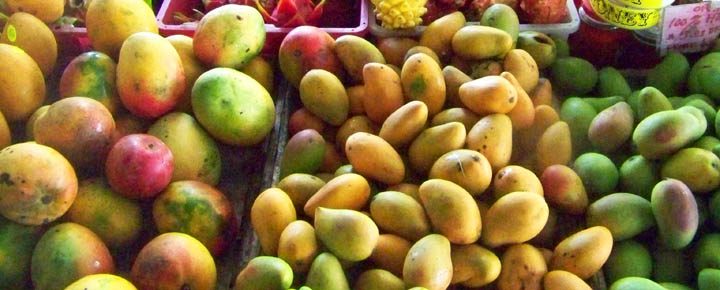

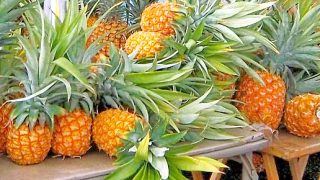
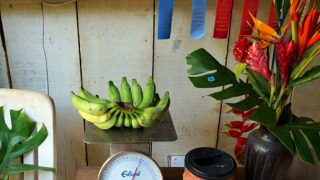
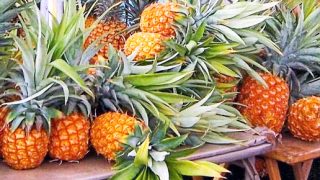
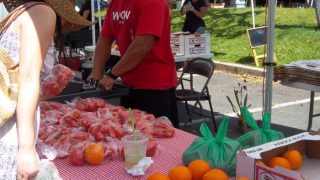
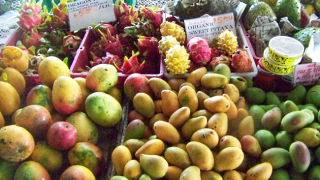
I have an interesting experience about transporting fresh fruit between islands. We had been on Kauai for 10 nights and going to Oahu for the final four of this trip. We had already gone through security and approaching our gate when we came to another agriculture inspection. We had to pass our carryons through the machine. The officer then asked to see our boarding passes. After reviewing them, she looks up at us and says with a stern look in her eye, “I see that you have papaya and pineapple in here.” We smiled and said we just didn’t have time to finish it before switching islands. We added that we were allowed to transport it inter-island. She says, “I know! But there is another group in there that are headed to the mainland and I just confiscated their fruit and they were not happy. If you promise me that you will not open this up and let anybody see the fruit, I will let you keep it.” We smiled and agreed. As we sat in the waiting area, I was peering around the room to see who may still have a wrinkled brow. But I saw none.
Watermelon is grown on Oahu it states. Can it be bought in Maui?
Aloha! Can you please comment on the news stories that are appearing regarding rat lungworm cases in Hawaii that have sometimes been attributed to fruit purchased at roadside stands? Mahalo.
Hi Susan.
Lungwork is associated with unwashed lettuce and that can come from grocery stores, farmers markets or anywhere else.
Aloha.
Hi
I was on Kauai in Feb 2016 and will be going back in August. I had starfruit from a farmers market that was the best I ever had and the sweet potatoes from the Food Lion were also the best I ever had. I know there are certain agricultural laws and I was wondering if anything besides pineapple can be brought back to the mainland. The produce was one of the highlights of my trip. Mahalo
Hi Nancy.
Pretty much pineapples and coconuts are all that you can bring back.
Aloha.
Farmers’ markets are te best source for most fruit, though markets such as Foodland have good specifically local sections in their produce departments. Lychee are wonderful right out of the refrigerator, cold and refreshing. And a bright orange papaya has a lot of delicious benefits. (Fresh island pineapple with Roselani Haupia ice cream is one of the world’s best desserts.)